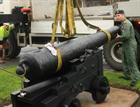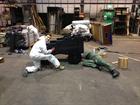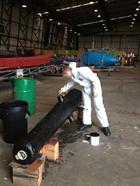HMS Anson's cannon returns to Culdrose
An 18th century Cannon with a significant historical past has returned to a prime spot at Royal Naval Air Station Culdrose after aircrew from 849 Naval Air Squadron carried out some much needed restoration.
Trainee Observers on the Airborne Surveillance and Control (ASaC) course 1/13 undertook the refurbishment after noticing that the cannon from HMS Anson was not looking its best. Using facilities on the Base the restoration began in April and despite having the rigors of the ASaC course to contend with set about the overhaul.
“On the face of it the job looked relatively simple”, said Lieutenant Allan McInnes, from 849 NAS. “Unfortunately, on closer inspection the carriage supporting the cannon was rotting and in need of replacement to ensure the 3.5 tonne cannon was secure. We asked around and RNAS Culdrose shipwright’s kindly offered their support and made a new carriage.”
The cannon itself has great historical significance; it once graced the decks of HMS Anson, a 64 gun third rate frigate launched in 1781 which sank off Loe Bar while attempting to return to Falmouth in December 1807, claiming the lives of over 100 sailors. A local man, Henry Trengrouse who witnessed the horror of the disaster set about inventing the ‘Breeches Buoy’ which is said to have saved thousands of lives since. The ‘Anson catastrophe’ also led to the passing of an act in Parliament which ensured that in future bodies washed up by the sea are given a proper burial in churchyards and parochial cemeteries, where before it was custom to dispose of the bodies in convenient pits on cliff tops.
Two cannons were recovered from the wreck in 1964 by Divers from the Naval Air Command Sub-Aqua Club, with the sister cannon currently reside outside the nearby Helston Museum. A monument to the drowned sailors now stands near Loe Bar, a short distance from the wreck.
In all, the team of part time Historical restorers from 849 NAS, Lieutenants Nicholas Fuller, Tom Longstaff, Allan McInnes and Sub lieutenant Paul Cataffo hope their contribution to Naval history will see the Cannon last for future generations to admire.
“I have always been interested in Naval History so this project really excited me, I am very proud to have been involved in the restoration of this significant piece of Cornish history” said Lt Nicholas Fuller on completion of the job.






